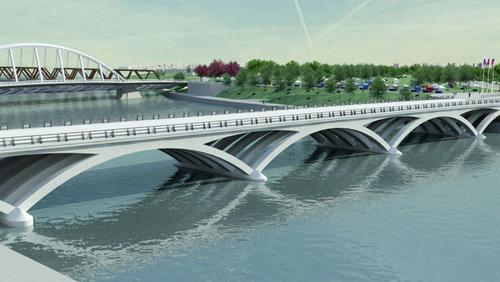Nature's Way to Relieve Stress Inspires Designs for Nearly Indestructible Bridges
An engineer in the United Kingdom has found inspiration in nature for the design of bridges that are far stronger and more durable than current designs.
July 21, 2016
An engineer in the UK has found inspiration in nature for the design of bridges that are far stronger and more durable than current designs.
Emeritus Professor Wanda Lewis in the School of Engineering at the University of Warwick has been studying how nature relieves stress for 25 years, taking an approach called “form-finding,” a process of shaping an object, or a structure, by loads applied to it, she told Design News in an interview. This process is different than engineering methods that start from an assumed shape and then check the stresses and displacements in a structure under an applied load, she said.
Form-finding enables the design of rigid structures that follow a strong natural form, structures that are sustained by a force of pure compression or tension without bending stresses, Lewis said. These stresses are the main points of weakness in structures and what causes bridges to fail or buckle under weight or stress and cause damage or even collapse.
“In form-finding, we go in the opposite direction -- the shape of the structure is not known initially, it is found by the application of load and involves repetitive calculations to find a shape that is in equilibrium with all forces,” she said.

An artist’s rending of the Rich Street Bridge in Ohio, an example of form finding to create more stable arches for bridge construction. Form finding is an approach taken by British engineer Wanda Lewis of the University of Warwick to observe how stress is balanced in nature and apply that to building stronger, more durable bridges. She said the Rich Street Bridge is a good example of how a form-found bridge might look.
(Source: Wanda Lewis/Department of Transportation, Ohio)
In her years of study, Lewis has found inspiration in different natural objects, such as how trees grow and bend in the wind, to design what she calls “moment-less arches” that more naturally distribute stress and load for bridge structures, according to an abstract of a paper published by The Royal Society.
“In the last few years I started to apply the form-finding approach to rigid-type structures, such as compressor blades, lightweight scaffolds for bone healing, and, presently, arch structures,” Lewis told us. “Each type of structure requires a different load to be used to shape its overall geometry and configuration. In fabric structures, the main load is surface tension; in arch structures, the compressive stress.”
This type of approach leads to structures that will have enhanced safety and long durability, without the need for repair or restructuring, Lewis said. This is because the structures will have the ability to take any combination of permanent loading without generating complex stresses, she said.
“Form-found structures resemble natural objects and are known to be highly optimized in terms of durability and weight/strength ratio,” she said. “Also, aesthetics is their inherent feature.”
READ MORE ARTICLES ON BIOMIMICRY:
While form-finding has proven in her work to create an optimal arch structure with natural stress- and load-bearing for bridges, this doesn’t mean it will be widely adopted anytime soon, Lewis said. There are a number of hurdles in conventional approaches and processes that first must be overcome, she said.
“First of all, form-finding needs to be acknowledged as an alternative approach to design,” Lewis said. “This will be difficult, because traditional training of architects and engineers is based on the assumption that we can build ‘whatever we like.’ Then, the design process has to rely on iterative computations using a specialist program.”
There are also construction challenges to adopting form-finding to bridge construction; specifically, the requirement for the structures to be built with extremely high precision, she added. However, Lewis said she believes that “these difficulties are a small price to pay for having durable and efficient structures.”
Elizabeth Montalbano is a freelance writer who has written about technology and culture for more than 15 years. She has lived and worked as a professional journalist in Phoenix, San Francisco, and New York City. In her free time she enjoys surfing, traveling, music, yoga, and cooking. She currently resides in a village on the southwest coast of Portugal.
About the Author(s)
You May Also Like
.jpg?width=300&auto=webp&quality=80&disable=upscale)


